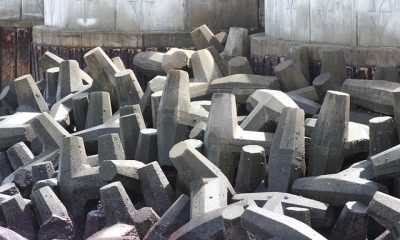Business
Forging the Future: Metal Stamping in Industrial Applications

Metal stamping, at its core, is a manufacturing process that employs dies to transform flat metal sheets into specific shapes. This technique, rooted in ancient practices, has evolved significantly over millennia, leveraging advances in technology and engineering to meet changing industrial demands. Today, the precision, durability, and efficiency offered by metal stamping make it a linchpin in modern manufacturing sectors.
When many hear the term “stamping,” their minds often drift to arts and crafts, envisioning decorative imprints on jewelry or personalized trinkets. Yet, beyond these artistic confines, metal stamping plays a pivotal role in producing everyday items—be it the car one drives, the phone in one’s pocket, or the structures that dot our skylines—highlighting the vast and versatile applications of this age-old technique in our industrialized world.
Understanding the Metal Stamping Process
At a fundamental level, metal stamping is the process of using die and punch combinations to transform metal sheets into desired shapes and forms, also known as metal stamps. This begins with flat sheet metal—often in the form of coils—which are fed into a stamping press. Within this press, the die and punch work in tandem: the die provides the necessary shape or contour, and the punch exerts force onto the metal sheet, thereby causing it to conform to the die’s design. The result can range from simple, flat shapes to three-dimensional parts.
One finds various specialized techniques under the metal stamping umbrella, each catering to different requirements. For instance, progressive stamping involves a series of stamping stations, each performing a specific operation on the metal as it moves through the sequence. Deep draw stamping, on the other hand, is utilized to create deep, hollow components by radially drawing a sheet into a forming die. Then there’s four-slide stamping, a multifaceted process that manipulates the metal at right angles for complex bends and twists. These are just a few examples, showcasing the nuanced approaches within metal stamping tailored to the different demands of modern industries.
Benefits of Metal Stamping in Industrial Applications
Metal stamping stands out as an invaluable process in various industrial sectors due to its multitude of inherent benefits. One of the most pronounced advantages is its precision. With meticulously designed dies and advanced machinery, manufacturers can achieve highly accurate and consistent parts, ensuring that each piece, from the first to the thousandth, adheres to exact specifications. This level of precision is paramount in industries such as aerospace or automotive, where the slightest deviation can compromise safety and performance.
Metal stamping is highly cost-effective, especially for large-scale production. Once the initial investment in die design is made, the per-piece production cost becomes relatively low, allowing for an economical means of mass-producing parts. Furthermore, the robustness and durability of stamped components are unparalleled, resulting in products that not only meet but often exceed lifespan expectations.
Key Industrial Sectors Utilizing Metal Stamping
The ubiquity of metal stamping in modern industry is a testament to its versatility and efficiency. One of the most prominent sectors that heavily relies on this technique is the automotive industry. Here, metal stamping is integral in creating a plethora of components, from the structural framework of vehicles to engine parts. The demands for strength, precision, and durability in automobiles necessitate the consistent and high-quality results that stamping provides, ensuring vehicles are both safe and long-lasting.
Simultaneously, the aerospace and defense sector stands as another testament to metal stamping’s significance. Given the stringent safety and performance standards in aerospace, components must be crafted with utmost precision, a task perfectly suited for metal stamping. Beyond this, consumer electronics manufacturers employ stamping for components like connectors, springs, and shields, ensuring that our daily gadgets function seamlessly. The construction industry, too, benefits from stamped metal parts for building materials and fixtures that withstand the test of time.
Innovations and Technological Advancements
With the march of technology, metal stamping has embraced numerous innovations, dramatically enhancing its capabilities. A salient example is the integration of Computer Numerical Control (CNC) technology. CNC stamping allows for unparalleled precision by automating the control of the stamping machines using computer-aided design and manufacturing software. This automation ensures that each stamped piece matches its design specifications to a tee, reducing the margin of error that might occur in manual operations.
The advent of 3D printing, or additive manufacturing, is ushering in a new era for metal stamping. While traditionally, stamping has been a subtractive process—starting with a larger piece of material and removing or shaping it to the desired form—3D printing allows for the creation of dies and components layer by layer, offering design possibilities previously deemed unfeasible. Additionally, the rise of automation and robotics in stamping processes has not only increased production speeds but has also significantly reduced the chances of human-induced errors and workplace accidents.
Environmental and Sustainability Implications
As industries worldwide pivot towards sustainability, metal stamping too faces its environmental reckoning. One of the primary advantages of the stamping process is its ability to reduce waste. By using pre-sized sheets and precision dies, metal stamping can maximize material usage, ensuring minimal scraps.
Many industries have adopted practices to recycle and reuse the waste produced, further lessening the environmental footprint. Advanced machinery has also been designed to consume less energy, bolstering efficiency and reducing carbon emissions. However, as demand grows, so does the need for raw materials, putting pressure on responsible sourcing and recycling.
Metal stamping stands as a cornerstone in modern manufacturing, bridging the gap between raw materials and the components that underpin our everyday lives. From its pivotal role in industries like automotive and aerospace to its influence in consumer electronics, the process exemplifies precision, efficiency, and adaptability.
FAQ:
Q: What is metal stamping?
A: Metal stamping is a manufacturing process that uses a machine tool called a press to shape metal sheets or coils into desired forms and sizes.
Q: What are the types of metal stamping?
A: Metal stamping includes blanking, piercing, forming, bending, drawing, coining, embossing, and flanging. Each type of metal stamping has a different purpose and effect on the metal sheet or coil.
Q: What are the advantages of metal stamping?
A: The advantages include high speed and accuracy, low cost and waste, high strength and durability, a wide range of materials and shapes, and easy integration with other processes.
Q: What are the disadvantages of metal stamping?
A: The disadvantages include the high initial investment, the limited flexibility and complexity, the high noise and vibration, the potential deformation and damage, and the safety hazards.
Q: What are the applications of metal stamping?
A: The metal stamping applications are automotive, aerospace, medical, electrical, construction, and consumer goods.





















































